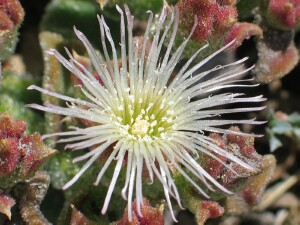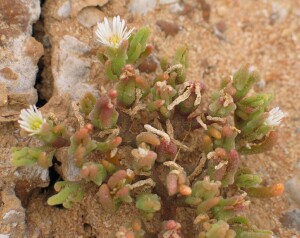Key to Pigfaces and similar plants
Leaves circular to triangular in cross-section (except for Common Ice Plant) and with daisy-like flowers (their ‘petals’ are actually sterile stamens or staminodes). This key is for naturalised species and may not apply to garden species and varieties. The key works by selecting one of the two choices given for each pair of descriptions, which lead to either another pair of descriptions or the identification of your species.
| 1. | Leaves and stems with prominent hairs, glands or papillae (pimples) | 2 |
| 1. | Leaves and stems more or less smooth or minutely warty | 4 |
| 2. | Stems covered in erect, hollow hairs; leaves and flower buds densely papillose (coastal) | Rodondo Creeper (Drosanthemum candens) |
| 2. | Leaves, stems and flower buds covered with glistening bead-like glands | 3 |
| 3. | Leaves flat and broad, to at least 5mm wide | Common Ice Plant (Mesembryanthemum crystallinum) |
| 3. | Leaves more or less terete (narrow cylindrical), up to 2mm wide | Small Ice Plant (Mesembryanthemum nodiflorum) |
| 4. | Leaves fleshy but broad and flat; flowers small with red ‘petals’ | Heart-leaf Ice-plant (Aptenia cordifolia) |
| 4. | Leaves terete to trigonous (triangular in cross-section); flower ‘petals’ not red | 5 |
| 5. | Leaves withering and soon deciduous, leaving the persistent leaf-bases on terete stems; flowers small with white ‘petals’ (far north-west) | Wiry Noon-flower (Psilocaulon tenue) |
| 5. | Leaves persistent; flowers with pink, purple or yellow ‘petals’ | 6 |
| 6. | Leaves less than 2 cm long, 1-3 mm wide and more or less terete | Little Noon-flower (Lampranthus tegens) |
| 6. | Leaves generally more than 3 cm long, more than 3 mm wide and more or less trigonous | 7 |
| 7. | Leaves with convex faces and rounded angles; flowers stalked; fruit a dehiscent capsule | Rounded Noon-flower (Disphyma crassifolium) |
| 7. | Leaves with slightly convex, flat or concave faces and sharp angles; flowers usually not noticeably stalked; fruit fleshy and indehiscent | 8 |
| 8. | Leaves minutely warty; flowers with 1-5 styles (far north-west) | Sarcozona (Sarcozona praecox) |
| 8. | Leaves smooth, flowers with 6-10 styles | 9 |
| 9. | ‘Petals’ yellow (coastal) | Hottentot Fig (Carpobrotus edulis) |
| 9. | ‘Petals’ pink to purple | 10 |
| 10. | ‘Petals’ pink throughout their length (though paler at the base) | Angled Pigface (Carpobrotus aequilaterus) |
| 10. | ‘Petals’ with white bases | 11 |
| 11. | ‘Petals’ generally less than 15 mm long; leaves bluish-green | Inland Pigface (Carpobrotus modestus) |
| 11. | Flowers 3.5 cm or more diameter ‘petals’ at least 15 mm long | 12 |
| 12. | Stamens in 5-6 series; 'petals' in 3-4 series leaves bluish-green (far-east Gippsland) | Glaucous Pigface (Carpobrotus glaucescens) |
| 12. | Stamens in 3-4 series; 'petals' in 2-3 series | 13 |
| 13. | Leaves usually green (coastal) | Karkalla (Carpobrotus rossii) |
| 13. | Leaves bluish-green (far north-west) | Long-leaf Pigface (Carpobrotus aff. rossii) |
 Common Ice Plant Photo: A J Brown |  Small Ice Plant Photo: A J Brown |  Rounded Noon-flower Photo: A J Brown |


